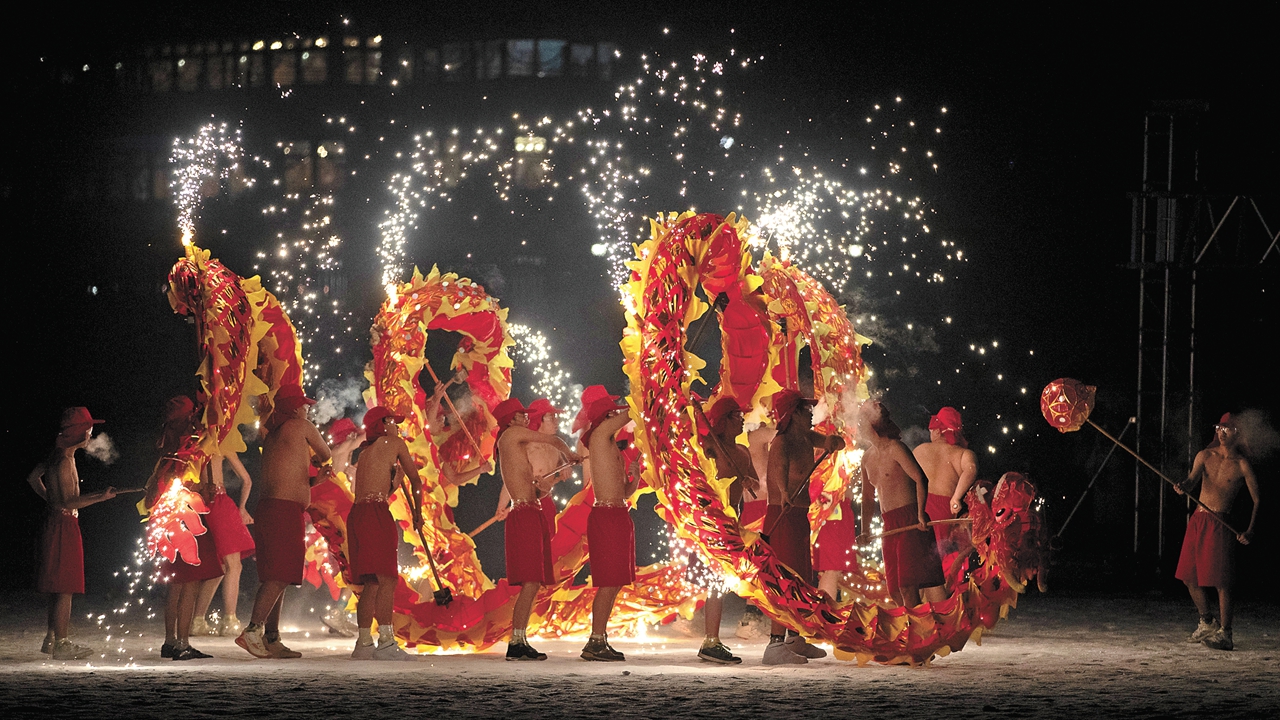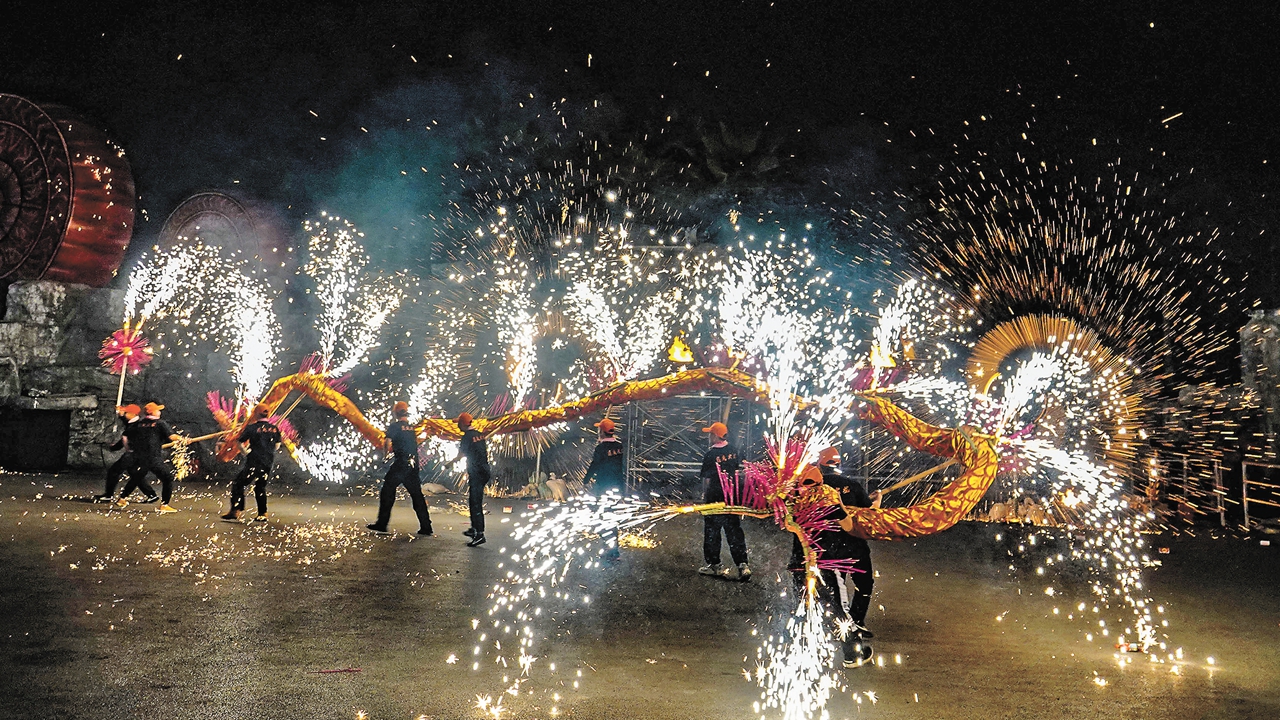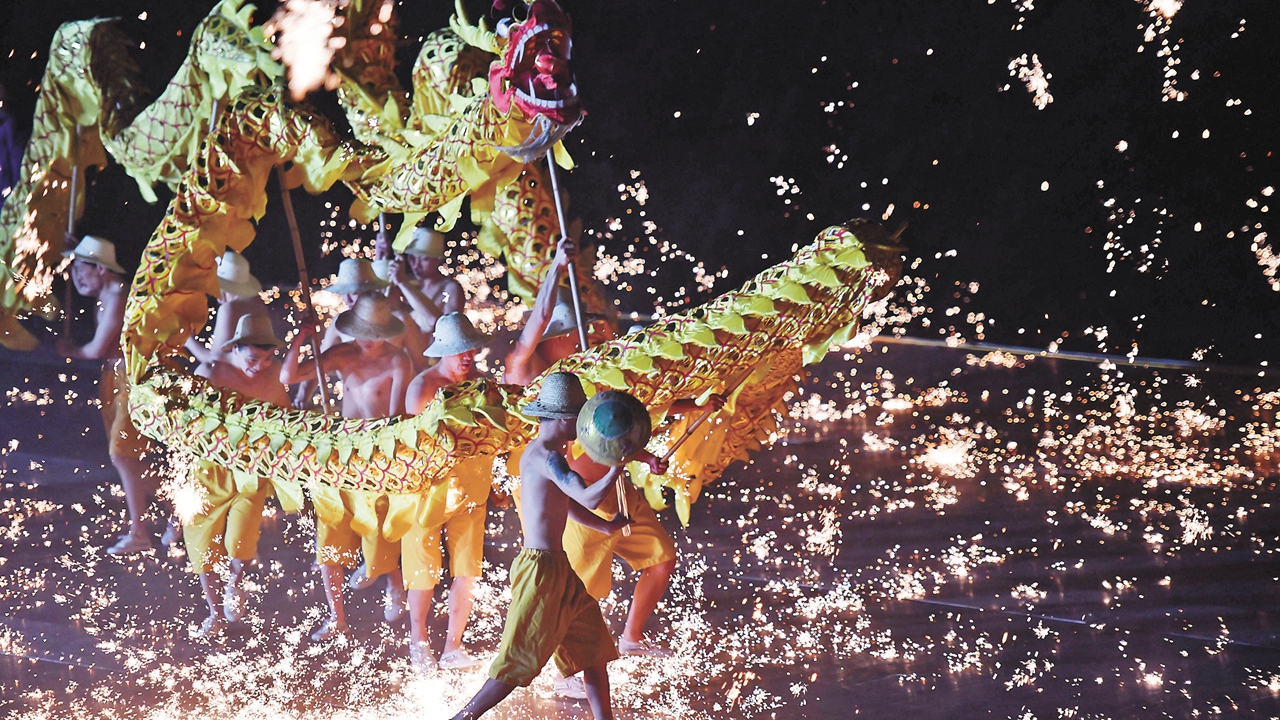Explore the spectacular fire dragon dance tradition
Writer: | Editor: Zhang Chanwen | From: Shenzhen Daily | Updated: 2024-03-04
Grab your camera and slap on something flame resistant, it’s time to witness one of China’s most incredible displays — the fire dragon dance.
The dragon, a sacred mythical creature in Chinese culture, is often the protagonist in festivities and rituals.
Dragon dances have been documented at ceremonial events since the Han Dynasty (202 B.C.-220 A.D.), while fire dragon dances began appearing in records during the Qing Dynasty (1644-1911). Some historians say fire dragon dances date back even further, to the Ming Dynasty (1368-1644).

Dragon dancers from Tongliang, Chongqing Municipality are performing under flying molten iron sparks at the Volga Manor in Harbin, Northeast China’s Heilongjiang Province in this Jan. 29 file photo. Photos by Xinhua
“These dances served purposes such as celebrating festivals and warding off plagues,” says Kwok Kam-chau, a professor at Hong Kong Baptist University whose research focuses on festivals and religion in Chinese societies.
“Throughout Chinese history, there are records of dragon worship ceremonies, yet they were associated with ‘water’ rather than ‘fire.’ In ancient times, people worshipped dragons to beseech for rain. This belief stems from folk religion, and Buddhist and Taoist belief, where dragons are revered as river gods or rain deities,” says Kwok.
From an anthropological perspective, he says the fire dragon procession route holds great significance “as it exemplifies the local villagers’ perception of their community and its geopolitical ties.”

Entertainers perform a fire dragon dance to celebrate the Chinese New Year in Nanning, Guangxi on Wednesday.
Today, fire dragon dances take place all over the country as part of Spring Festival festivities, but performances differ in shapes and forms.
Here are some top options for travelers looking to experience this fiery Chinese tradition in person.
Puzhai Fire Dragon, Guangdong
Puzhai Village, located in Fengshun County, Guangdong Province, has been hosting fire dragon dance shows every year during China’s Lantern Festival, which falls on the 15th day of the Lunar New Year (Feb. 24 this year), since the Qing Dynasty.
The centuries-old tradition was listed as a national intangible cultural heritage in 2008.
As the firecrackers are lit, a flurry of shirtless men rush into the village plaza, all working together to hoist a dancing dragon that’s over 30 meters long and is covered in fireworks that make its body sparkle brightly.
The event usually begins with various fireworks displays and performances, before a village elder lights the fireworks that are set along the livery of the colorful dragon, bringing the festivity to its climax.
Xiangxi Steel Fire Dragon, Hunan
The Steel Fire Dragon Dance has been performed in different towns in China’s Xiangxi Tujia and Miao Autonomous Prefecture, in Hunan Province, for centuries.
Observed annually during the Lantern Festival, the dance is believed to bring good weather and abundant harvests in the coming year.
It often begins with a cacophony of drums and gongs, firecrackers and cheers from onlookers.
Then, fireworks shoot out from the many bamboo pipes that flank the dance route, as dozens of dragon dancers brave the sparks that rain down.
Some of the dances end by running the dragon into a river, others aren’t over until the dragon is completely burnt out, its metal structure all that remains.
Once feared as a dying tradition, the dance has been revived thanks to the enthusiastic locals who tirelessly promoted it online by sharing dramatic images and clips of the event.
The Steel Fire Dragon dance was added to China’s list of intangible cultural heritage in 2018.

A fire dragon dance is performed by the side of the Jinjiang River in Chengdu, Sichuan Province in this file photo.
Huanglongxi Ancient Town Fire Dragon, Sichuan
To see a majestic fire dragon dance against a historical backdrop, head to Huanglongxi in Sichuan Province.
Filled with ancient architecture from the Qing Dynasty, this historic old town in the city of Chengdu is known for its many temples, making it a popular destination.
Every year, the town hosts a multi-day Lunar New Year fair by the pier that includes a fire dragon dance on each of the first five days (Feb. 10-14 this year) as well as the 15th day (Feb. 24) of the lunar month.
No firecrackers here. Instead, molten iron lava is thrown into the air. As the lava cools and sends sparkles into the air, the dragon “pursues” a lantern, creating a spectacular show.
Tongliang Fire Dragon, Chongqing
The Tongliang Fire Dragon in Chongqing Municipality is undoubtedly one of the grandest fire dragon dance performances of them all. As droplets of molten iron are shot into the sky and light up the darkness, the shadow of the fire dragon swirls around majestically.
Dubbed the hometown of the fire dragon, Tongliang District now takes the show on the road, hosting dances in other parts of Chongqing, and even in other parts of China. But one of the top places to take it in is Qicaimeng Park.
Although visitors have missed a 50-minute folk art performance every night from Feb. 10 to 17 this year, they are still in time for the 10-minute Tongliang Fire Dragon show that runs until Feb. 24 as well as on March 1, 2, 8 and 9. There will also be other illumination displays and fairs going on within the park.
Dafang County Dragon Dance, Guizhou
The Ancient Town of Liulong, in Dafang County, Guizhou Province, kicks off its annual Dragon Lantern Festival on the ninth day of the lunar month (Feb. 18). Dragon dance performances will be given every day until the evening of the Lantern Festival (Feb. 24).
Instead of lighting the dragon on fire, Dafang’s version features an elaborate and colorful lantern that’s lit from within.
Dozens of firecrackers are laid on the ground to create a glittery display around the parade route as dancers move around the town’s plaza with their dragon.